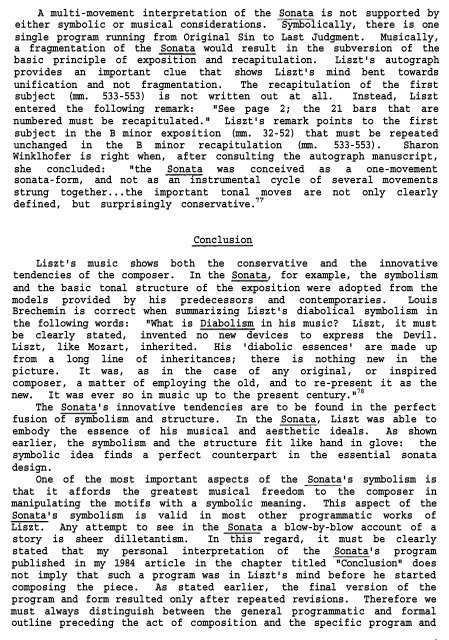LISZT'S SYMBOLISM AND MUSICAL STRUCTURE by Tibor Szász ...
LISZT'S SYMBOLISM AND MUSICAL STRUCTURE by Tibor Szász ...
LISZT'S SYMBOLISM AND MUSICAL STRUCTURE by Tibor Szász ...
You also want an ePaper? Increase the reach of your titles
YUMPU automatically turns print PDFs into web optimized ePapers that Google loves.
A multi-movement interpretation of the Sonata is not supported <strong>by</strong><br />
either symbolic or musical considerations. Symbolically, there is one<br />
single program running from Original Sin to Last Judgment. Musically,<br />
a fragmentation of the Sonata would result in the subversion of the<br />
basic principle of exposition and recapitulation. Liszt's autograph<br />
provides an important clue that shows Liszt's mind bent towards<br />
unification and not fragmentation. The recapitulation of the first<br />
subject (mm. 533-553) is not written out at all. Instead, Liszt<br />
entered the following remark: "See page 2; the 21 bars that are<br />
numbered must be recapitulated." Liszt's remark points to the first<br />
subject in the B minor exposition (mm. 32-52) that must be repeated<br />
unchanged in the B minor recapitulation (mm. 533-553). Sharon<br />
Winklhofer is right when, after consulting the autograph manuscript,<br />
she concluded: "the Sonata was conceived as a one-movement<br />
sonata-form, and not as an instrumental cycle of several movements<br />
strung together...the important tonal moves are not only clearly<br />
defined, but surprisingly conservative. 77<br />
Conclusion<br />
Liszt's music shows both the conservative and the innovative<br />
tendencies of the composer. In the Sonata, for example, the symbolism<br />
and the basic tonal structure of the exposition were adopted from the<br />
models provided <strong>by</strong> his predecessors and contemporaries. Louis<br />
Brechemin is correct when summarizing Liszt's diabolical symbolism in<br />
the following words: "What is Diabolism in his music? Liszt, it must<br />
be clearly stated, invented no new devices to express the Devil.<br />
Liszt, like Mozart, inherited. His 'diabolic essences' are made up<br />
from a long line of inheritances; there is nothing new in the<br />
picture. It was, as in the case of any original, or inspired<br />
composer, a matter of employing the old, and to re-present it as the<br />
new. It was ever so in music up to the present century." 78<br />
The Sonata's innovative tendencies are to be found in the perfect<br />
fusion of symbolism and structure. In the Sonata, Liszt was able to<br />
embody the essence of his musical and aesthetic ideals. As shown<br />
earlier, the symbolism and the structure fit like hand in glove: the<br />
symbolic idea finds a perfect counterpart in the essential sonata<br />
design.<br />
One of the most important aspects of the Sonata's symbolism is<br />
that it affords the greatest musical freedom to the composer in<br />
manipulating the motifs with a symbolic meaning. This aspect of the<br />
Sonata's symbolism is valid in most other programmatic works of<br />
Liszt. Any attempt to see in the Sonata a blow-<strong>by</strong>-blow account of a<br />
story is sheer dilletantism. In this regard, it must be clearly<br />
stated that my personal interpretation of the Sonata's program<br />
published in my 1984 article in the chapter titled "Conclusion" does<br />
not imply that such a program was in Liszt's mind before he started<br />
composing the piece. As stated earlier, the final version of the<br />
program and form resulted only after repeated revisions. Therefore we<br />
must always distinguish between the general programmatic and formal<br />
outline preceding the act of composition and the specific program and



